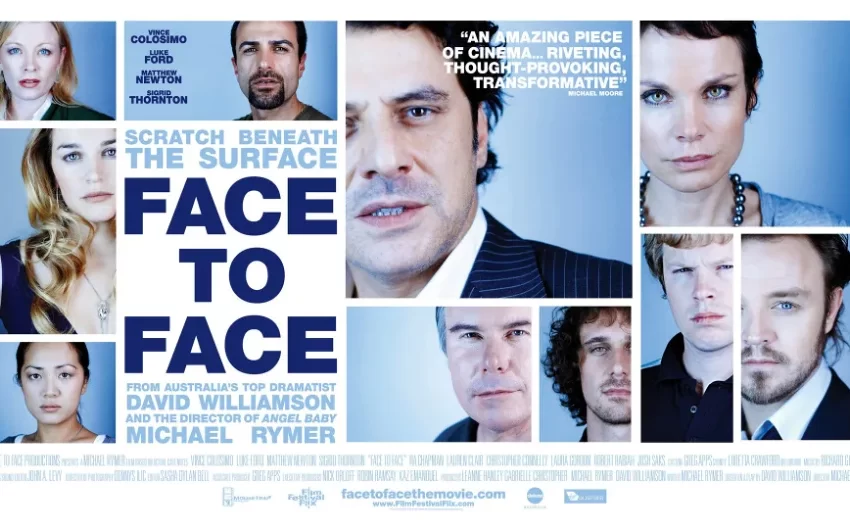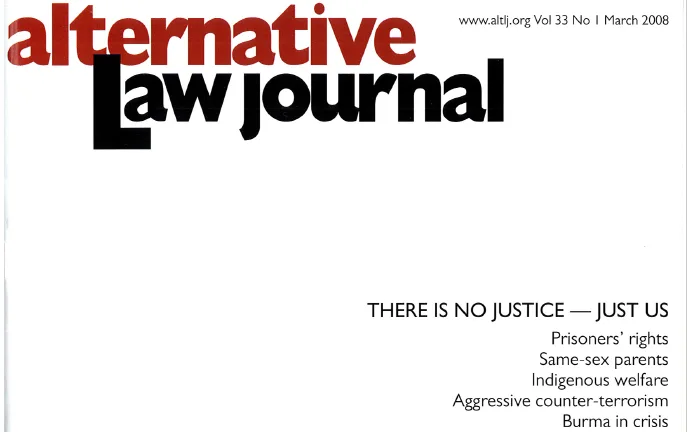
Executive Summary
Institutional Betrayal costs organisations millions through increased turnover, legal expenses, and lost productivity. This article summarizes a recent discussion between three experts from diverse backgrounds, exploring how leading organisations are using Institutional Courage to transform workplace culture, resulting in documented cost savings and improved performance. Learn practical steps to implement these changes in your organisation.
Introduction
More than ever, trust is a factor that directly impacts the bottom line. In an age where everyone has a bullhorn (or a microphone, or an Instagram account), organisations must devote even more attention to building and safeguarding the trust of multiple stakeholders, including employees, shareholders, clients, and the broader public. Doing so while also ensuring the operational efficiency of the enterprise is a complex undertaking, and that complexity was brought into sharp focus during a recent discussion between Dr. Alec Smidt, Co-Founder of Alto Group and Dr. Tarah Hodgkinson, Assistant Professor of Wilfrid Laurier University and a consultant with SafeGrowth. The conversation, facilitated by Richard Hart, a Founder of ProActive ReSolutions, shed light on how organisations can overcome instances of Institutional Betrayal through the development of Institutional Courage, and provided powerful insights into the role of restorative and transformative justice in these contexts.
Dr. Alec Smidt began the conversation by sharing his own insights into 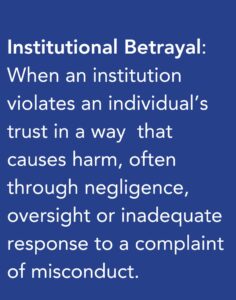 Institutional Betrayal, gained both from his time as a researcher in university collaborating with Dr. Jennifer Freyd, who originated and coined the concepts of Institutional Betrayal and Institutional Courage, and subsequently from his continuing work with Dr. Freyd as co-founders of Alto Group, focusing on organisational risk and resilience. Alec explained that Institutional Betrayal is a particular form of psychological harm that arises where institutions harm individuals who are reliant on them or have placed significant trust in the organisation. That harm typically arises through negligence, oversight, or an inadequate response to complaints of misconduct by other individuals.
Institutional Betrayal, gained both from his time as a researcher in university collaborating with Dr. Jennifer Freyd, who originated and coined the concepts of Institutional Betrayal and Institutional Courage, and subsequently from his continuing work with Dr. Freyd as co-founders of Alto Group, focusing on organisational risk and resilience. Alec explained that Institutional Betrayal is a particular form of psychological harm that arises where institutions harm individuals who are reliant on them or have placed significant trust in the organisation. That harm typically arises through negligence, oversight, or an inadequate response to complaints of misconduct by other individuals.
With that background, Dr. Tarah Hodgkinson then offered some examples from her experiences from researching with police agencies, to explore how Institutional Betrayal can play out on the ground—with severe implications both for officers and community members.
The antidote to Institutional Betrayal, as our discussion revealed, is Institutional Courage—a conscious commitment by organisations to create environments that honor transparency, responsibility, and trust. In this article, we build on Alec and Tarah’s discussion to explore the importance of Institutional Courage, illustrate its practical application, and explain how transformative justice can address the gaps created by Institutional Betrayal.
With that overview of the conversation, let’s now dive in a little deeper into the conversation.

Institutional Betrayal — What is it?
As Alec explained, Institutional Betrayal occurs when institutions fail the very people they are supposed to protect. This can happen in many ways. Alec highlighted a poignant example where an organisation, after receiving multiple complaints from employees regarding misconduct by an individual, failed to act. He pointed out that the failure to respond appropriately wasn’t just an administrative oversight—it was a profound betrayal of trust that had ripple effects across the entire organisation, decreasing morale and eroding employee commitment.
Tarah then drew a parallel from her experiences with policing organisations. She observed that when police agencies fail to act on internal reports of misconduct, it doesn’t only harm those directly affected—it also sends a message to the entire workforce that their concerns are not valued. “When officers see their colleagues get away with misconduct, they lose faith in the institution,” Tarah said. Richard noted that the same issues arise when concerns raised by members of the community ignored, minimised or denigrated by police agencies, rather than being dealt with in a fair and transparent way. Such scenarios erode the moral fabric of the organisation, affecting performance, morale, and ultimately the safety of the community.
Tarah also pointed to examples of leaders in police organisations failing to act on recommendations to improve the workplace, despite their prior commitments to do so. As Tarah so eloquently said, “It means something to officers when their leaders make a big show of engaging outside people to hear feedback and input and make recommendations. It means something to officers when leaders commit to acting on those recommendations. And it means something to officers when leaders break those promises.”
Institutional Courage – a Restorative Alternative
After this consideration of these different harms, Alec and Tarah then turned to consider protection and remediation. They focused particularly on Alec’s assertion that Institutional Courage is an “antidote” to Institutional Betrayal.
Alec provided an overview of Institutional Courage, describing it as “tangible 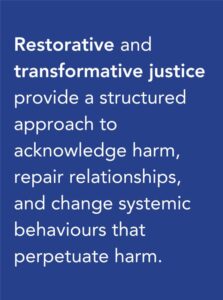 actions and policies that prioritize transparency, ethical behavior, and proactive support for individuals within an organization.” He went on to outline the several key elements of Institutional Courage that he, Jennifer Freyd, and their colleagues have identified from their research: leadership transparency, safe reporting mechanisms, restorative responses, empowered voices, cultural alignment, and support & reintegration.
actions and policies that prioritize transparency, ethical behavior, and proactive support for individuals within an organization.” He went on to outline the several key elements of Institutional Courage that he, Jennifer Freyd, and their colleagues have identified from their research: leadership transparency, safe reporting mechanisms, restorative responses, empowered voices, cultural alignment, and support & reintegration.
Richard, hearing the reference to “restorative”, jumped in to note the obvious alignment between this conceptualization of Institutional Courage and Restorative Justice, a well-established approach to healing harm that prioritizes dialogue, accountability, and well-being for all stakeholders.
Tarah then leveraged the frameworks of both Institutional Courage and Restorative Justice in sharing several stories of transformation her team had led within police departments, effectively turning punitive cultures into ones that prioritize healing and reconciliation.
One of those stories was about the Calgary Police Services, which introduced restorative practices such as accessing local knowledge into their domestic conflict response. That initiative led to a number of critical outcomes, including an increased sense of safety among community members and decreased costs. “Restorative practices allowed the community and police to work together to find a solution rather than just blame,” Tarah noted. Alec built on this, emphasizing that restorative practices not only address harm but also foster a forward-looking sense of community. The idea isn’t just to repair the past but to build structures that prevent harm from happening again.
A particularly striking example referenced by Alec was that of the UK’s National Health Service. The organisation implemented what they called a ‘Just and Learning Culture’, a set of restorative practices that led to remarkable outcomes including a substantial reduction in absenteeism and legal costs, along with significantly improved overall morale among staff. These practices helped create an environment where staff felt comfortable speaking up about mistakes and concerns, knowing that their voices would be heard rather than dismissed. The economic impact of these practices was significant as well—saving millions annually—showing that fostering Institutional Courage is not only ethically right but financially beneficial.
Alec’s recent research, co-authored with Jennifer Freyd and Alexis Adams-Clark, found that among employees exposed to workplace sexual harassment, institutional courage was associated with both improved outcomes, such as increased job satisfaction and organisational commitment, and reduced harms, including fewer physical health symptoms and less workplace withdrawal linked to institutional betrayal.
Institutional Courage: Getting Started
Alec described Institutional Courage as a foundational principle for ethical and effective organisations. He highlighted his and Jennifer Freyd’s work at Alto Group, where they are actively embedding this principle into cutting-edge risk management and organisational change strategies. “Institutional Courage isn’t just about responding to harm; it’s about embedding transparency and accountability into the DNA of an organization,” Alec said, emphasizing that this approach provides organisations with the tools to build trust, prevent harm, and foster cultures of accountability and resilience.
Richard emphasized that fostering Institutional Courage also requires proactive leadership. “Courageous leadership means being willing to look at uncomfortable truths and make changes even when it’s difficult,” Richard stated. This is where restorative and transformative justice play a crucial role—they provide a structured approach to acknowledge harm, repair relationships, and change systemic behaviours that perpetuate harm.
In a policing context, Tarah highlighted how Institutional Courage could look on 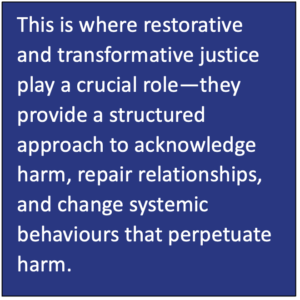 the ground. She spoke of efforts to implement a restorative approach where officers who were involved in incidents of misconduct were encouraged to take part in dialogues with affected colleagues and community members. “It’s about understanding the harm caused and working towards accountability—not in a punitive sense, but in a way that genuinely addresses the harm,” Tarah explained. The impact of these approaches is far-reaching, with communities reporting higher satisfaction and reduced recurrence of issues.
the ground. She spoke of efforts to implement a restorative approach where officers who were involved in incidents of misconduct were encouraged to take part in dialogues with affected colleagues and community members. “It’s about understanding the harm caused and working towards accountability—not in a punitive sense, but in a way that genuinely addresses the harm,” Tarah explained. The impact of these approaches is far-reaching, with communities reporting higher satisfaction and reduced recurrence of issues.
Economic and Cultural Benefits
The benefits of embracing Institutional Courage extend beyond culture—they are also economic. The NHS example highlights how moving from a punitive to a restorative model can drastically cut costs associated with absenteeism, legal fees, and especially staff turnover. Tarah noted, “When staff know they are supported, absenteeism drops. People feel valued and want to contribute.” Alec added that these cultural changes lead to a more resilient organisation—one better equipped to navigate complex challenges and adapt to change.
There is much research substantiating broad benefits to this approach, including improved satisfaction and reduced recidivism. These findings are consistent with what we have seen at ProActive ReSolutions, where our global expertise in applying restorative practices has helped organisations across sectors—from healthcare to law enforcement—achieve both cultural transformation and economic stability.
Moving Forward: Fostering Institutional Courage
To foster Institutional Courage, organisations must take several key steps:
1. Acknowledge Past Failures: Institutions need to recognise their past failures openly. As Alec emphasized, transparency is the cornerstone of building trust.
2. Empower All Voices: Organisations need to create channels where all employees feel they have a voice. Restorative practices are especially powerful here, as they give frontline workers an opportunity to participate meaningfully in decision-making.
3. Embed Restorative Practices: Introducing restorative justice at all levels—from the frontlines to executive leadership—is essential to cultivating Institutional Courage.
4. Train Leaders in Restorative Principles: Leaders must understand and practice restorative justice principles to lead effectively through complex challenges. “It starts at the top,” Richard noted, “Leaders set the tone for whether courage or betrayal will define an institution.”
Conclusion
The conversation between Alec, Tarah, and Richard underscores that fostering Institutional Courage is not an easy task. It requires dedication, transparency, and a willingness to challenge entrenched practices. However, the payoff is immense: a culture of trust, improved morale, increased productivity, and economic savings. By learning from examples like the NHS and applying the principles of restorative justice and Institutional Courage, organisations can transform themselves from sources of betrayal to pillars of trust and empowerment.

 Australia
Australia
 USA
USA


